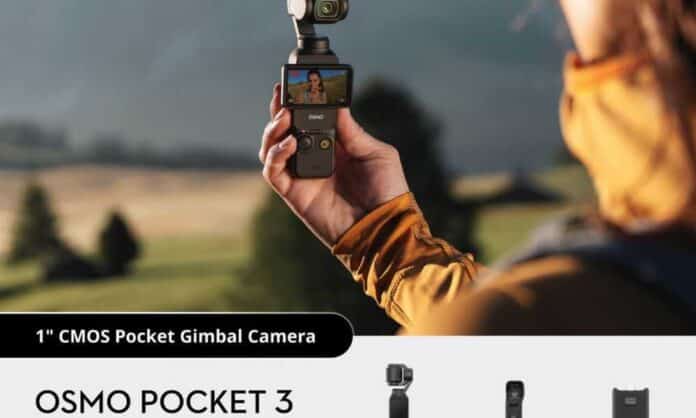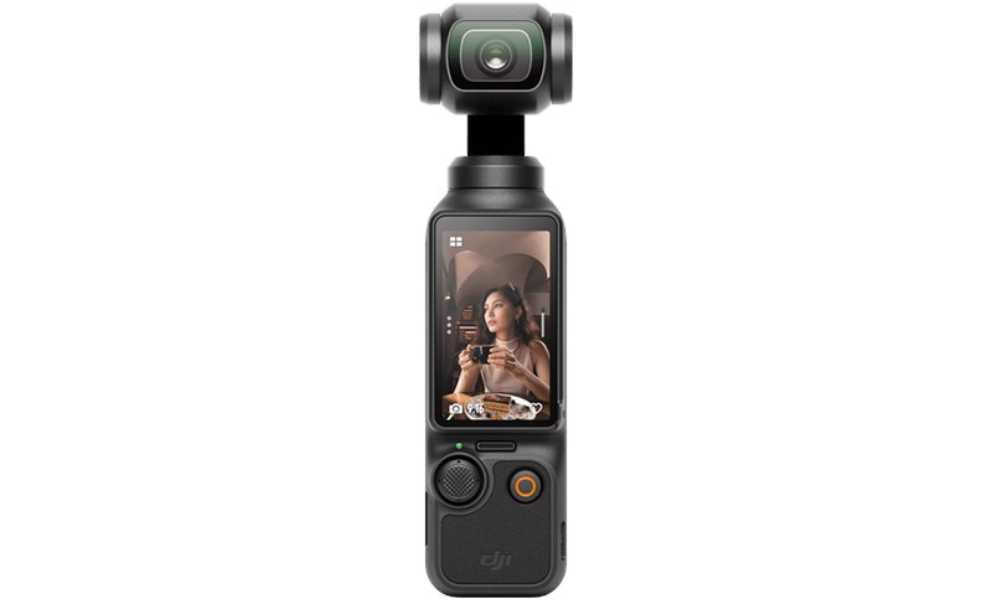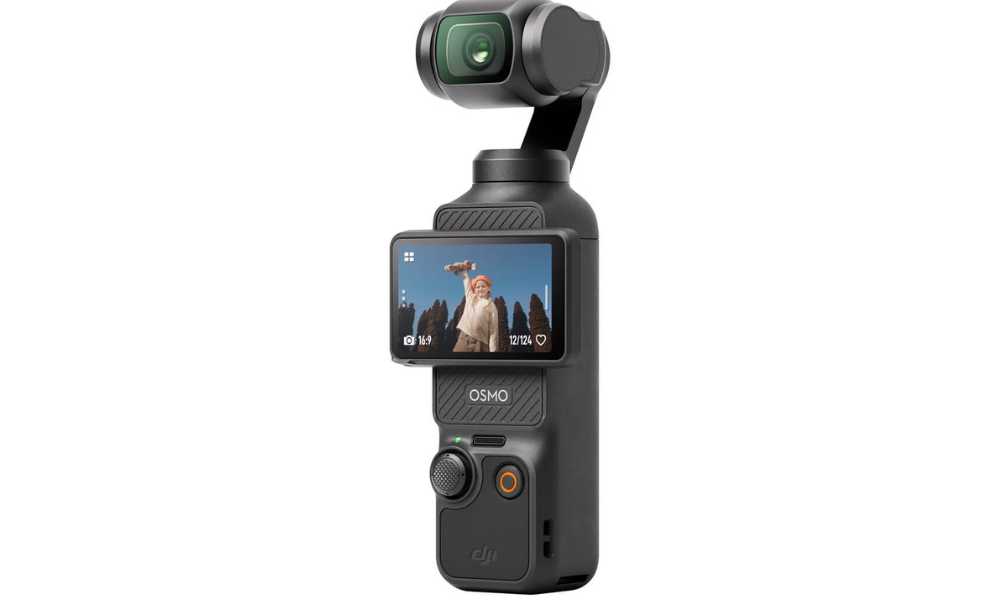In 2020, DJI launched the Osmo Pocket 2, a notable upgrade from its predecessor. Three years later, the Osmo Pocket 3 has arrived with even more extensive and comprehensive improvements. The new model boasts a 1-inch sensor, supports 4K 120fps slow-motion video, features full-pixel rapid autofocus, and comes with a three-axis gimbal for enhanced stabilisation. It also offers true-tone skin colour, Glamour Effects 2.0, a 2-inch rotating touchscreen for easy switching between portrait and landscape modes, ActiveTrack 6.0, stereo audio capture, and compatibility with DJI Mic 2. These features solidify the Osmo Pocket 3’s status as a top-tier pocket gimbal camera.
The DJI Osmo Pocket 3 comes in two combo options: the Standard Combo and the Creator Combo. The Standard is priced at $849, while the Creator costs $1129.
The Creator Combo for the DJI Osmo Pocket 3 includes several new accessories such as a battery handle, DJI Mic 2 transmitter, mini tripod, wide-angle lens and a carrying case. Despite the price increase from the Osmo Pocket 2, the enhanced hardware specifications and comprehensive feature upgrades of the Osmo Pocket 3 make it competitively priced.
Design: The rotating touchscreen offers a larger display area.
In terms of appearance, the Pocket 3 maintains the core design of the first-generation three-axis stabilisation system. However, DJI has made bold adjustments to the product’s form, most notably upgrading the tiny screen of the previous two generations to a 2-inch rotatable larger display.
Check out: What is 4K Video Recording? Complete Guide
Looking at the device alone, the overall size of the Pocket 3 hasn’t increased dramatically compared to its predecessor. The Pocket 3 is 139.7mm in length, about 1.5cm longer than the 124.7mm Pocket 2. While it’s slightly wider and thicker, it remains compact.
The camera gimbal module is larger due to the upgrade from the 1/1.7-inch CMOS in the Pocket 2 to the 1-inch CMOS in the Pocket 3. Nevertheless, the camera gimbal module of the Pocket 3 is still quite well-sized in comparison.
As for the lens specs, the Pocket 3 uses a 20mm F2.0 lens, whereas the Pocket 2 has a 20mm F1.8 lens. Although the aperture on the Pocket 3 is slightly smaller, the much larger sensor size means it performs better in terms of light intake and background blur than the previous generation.
The screen design is one of the biggest changes in the appearance of the Pocket 3. It features a 2-inch rotatable screen, a significant upgrade from the mini display of the previous generation. The rotating screen is a clever design choice; due to the slim body, it’s challenging to use a narrow horizontal space for a large display when shooting landscape videos. The Pocket 3’s rotating screen caters to both landscape framing and ensures complete composition when shooting in portrait mode, making it doubly effective.
Image Quality and Features: Excellent, rich, and meets the needs of creators.
The DJI Osmo Pocket 3 offers a wealth of video capabilities, catering to various creative needs with ease. Whether it’s standard video recording, slow-motion, low-light filming, vertical video, time-lapse, 180-degree rotation – all these modes are readily accessible directly on the device or through the DJI Mimo app. The interface is intuitive and user-friendly, allowing even new users to quickly get started.
As for image quality, the Osmo Pocket 3 delivers exceptional results straight out of the camera, particularly notable at 4K resolution with its sharpness and detailed imagery. Dynamic range has been visibly improved from the previous generation, offering better detail in highlights and shadows even in high-contrast or backlit situations. With the D-Log M colour profile, users gain a wider latitude for post-production and colour grading.
In low-light environments, the low-light video mode is worth trying. Supporting up to 4K 30fps, it produces cleaner imagery with less noise. I’ve tested it at night for both landscapes and portraits, and thanks to the 1-inch sensor, the videos had a remarkable dynamic range, as demonstrated in the video above, making it a great option for night-time shooting.
When filming vlogs or selfies, you can enable the beauty retouch features on the DJI Osmo Pocket 3. The device offers a natural skin brightening effect and fine-tunes for different skin tones using a face-priority exposure strategy. It also supports Glamour Effects 2.0, which can be toggled on and off from the Osmo Pocket 3’s interface or the DJI Mimo app, with various customizable settings. Additionally, users can purchase a new accessory, the beautifying soft light filter, which enhances the video with a soft-glow effect on highlights and softer skin, adding to the overall ambiance.
ActiveTrack 6.0: Two new practical features added.
ActiveTrack 6.0 allows you to double-tap the subject on the video screen or select the subject in the DJI Mimo APP for tracking, ensuring the subject remains locked in the centre of the frame.
Moreover, two new practical features have been added: Protagonist Tracking Mode and Pre-composition Tracking Mode. With Protagonist Tracking Mode, the camera automatically follows the first face that appears in the centre when recording starts. Pre-composition Tracking Mode allows you to select a desired composition within the viewfinder, using the rule of thirds or the golden spiral (adjusted via the joystick). Once the subject enters the predefined area, you press the joystick to start intelligent tracking, keeping the subject at the chosen compositional point.
The DJI Osmo Pocket 3 maintains a stable focus lock on the subject, unaffected by distractions. These two new features are quite practical and offer significant convenience for vlogging with human subjects, making it easier to achieve various compositions during filming.
That wraps up our review and introduction of the DJI Osmo Pocket 3, the flagship gimbal camera for on-the-go filming. Overall, the DJI Osmo Pocket 3 remains a compact and portable video recording powerhouse. It’s not only convenient to carry and store but also a pleasure to use, offering freedom in video creation without being hindered by size or weight.
Check out: DJI Mini 2 palm-sized drone flies more and shoots 4K videos for $449



